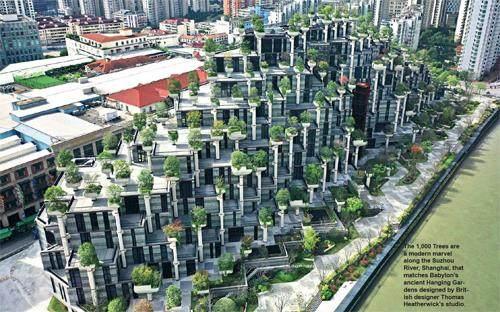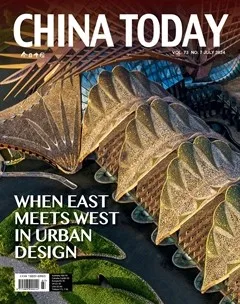Visions of the 21st Century City:Nature Integrated into Urban Design
ROSA CERVERA

HOW do you envision the ideal 21st centurycity? This is a question that invitesyou, the reader, to give full rein to yourimaginings of a city that embodies all youever dreamed of as a place to live. Currently, morethan half of the world's population lives in cities,many of them vast metropolises. The developmentmodel that modern society deems to be the basisof progress is that of “steady growth” – a philosophyof unlimited expansion that propels todays insatiableconsumption of resources and scale of humansettlements. The urban development of contemporarymegacities sprawls unboundedly across theirchosen territory, so distancing themselves fromnature and engendering a profound division betweennatural and urban ecosystems. Citizens havebecome accustomed to an environment of concrete,brick, and asphalt to the extent of accepting theseharsh settings, which indeed constitute their habitat,as a normal backdrop for their daily activities.UN projections show that the global population willcontinue to grow in the coming decades; and consequentlymegacities will proliferate and further fracturetheir dysfunctional relationship with nature dueto distancing humans from the natural ecosystem towhich they belong.
Since ancient times, Chinese culture has upheldthe idea of living in harmony with nature. TheChinese word for landscape (风景, fengjing ) firstemerged in ancient times, long before it appeared inmany other cultures. Conveying the need for a harmoniousand balanced encounter between humansand nature, the concept is reflected in such artisticexpressions as poetry and painting, as well as in architectureand the splendid gardens of the Chinesetradition. Owing to exponential growth proceedingfrom rationalistic thinking and the IndustrialRevolution, however, humanity, along with the newsocial model, has become even more separatedfrom the nature to which it belongs.
In this era of urban expansion and rapid growthof densely populated cities, therefore, it is crucial to ask ourselves how urban models may be improved,so as to create cities that both fulfill their essentialfunctions and enhance the lives of citizens on boththe physical and emotional levels. Although contemporaryurban planning cannot ignore the essentialissues of water supply, clean energy provision,sustainable and comfortable mobility, waste managementand recycling, as well as air quality andpublic health, among others, there are other vitalaspects to be considered in the concerted effort toreconnect with nature.
The current resource-exhausted urban models,which insist on “paving” the planet, need instead toincorporate new ideas that make urban space moreenvironment-friendly. The compact city, whichshuns the predatory extension of its encompassingterritory and consequent loss of its indigenous plantspecies, instead including nature as an essentialelement of urban organization, is a concept thatshould preside over future planning alternatives.
Introducing nature into the urban and territorialplanning system for sustainable development means taking into account certain plant speciesand the benefits they bring us. This means also takinginto account water and its cycle, the surroundingterritory and its landscape and natural value,and ultimately changing the mindset wherebynature is considered as no more than something tobe extracted for purposes of consumption, utilization,and depredation.
Rebalancing the built and the natural environmententails considering the entire range of greenspaces – from the most extensive and encompassing,to that most confined within the city limits –as essential to the urban fabric. The former includessurrounding rural and agricultural territory, forests,parks and peri-urban green corridors, and largegreen infrastructures. The latter, meanwhile, includenature reserves and parks within the city, urbanorchards and cultivable areas, and gardens, amongothers. However, the average city of today seldomhas sufficient space to incorporate nature. This iswhy other alternatives have appeared during recentyears, which use nature-based solutions to cultivatethe green surfaces of buildings and infrastructures,be they fa?ades, walls or roofs, thus giving rise tonew types of roof gardens, green fa?ades, and verticalgardens.
Among such innovations that regard the architectural“envelope” as a versatile surface, we wouldmention one under development in the city of Alcorcón, in the metropolitanarea of Madrid (Spain).It entails cultivating microalgae on architecture thatfeatures a new type of greenfa?ade. As the basis of all lifeon our planet, algae presentan alternative in regard to thefuture of humanity. Cultivatedon architecture, microalgaeare known as carbon mitigatorsdue to their high capacityof CO2 sequestration by uptaking 1.8 kg of CO2 perkg of biomass, hence contributing significantly tosubstituting the paradigm of the city as a consumerfor that of a producer of bio-energy.
There is one more way we would mention of approachingnature through architecture. Concern forenvironmental problems – such as the lack of energythat results in excessive consumption of naturalresources – motivates us to investigate other paths.We are driven by the conviction that it is possible tolocate a better architectural response based on thewisdom of the natural forms existent on our planet.These are beautiful but at the same time highlyefficient in consuming minimal resources to fulfiltheir vital function.
This approach embodies the dual vision of servingas both a source of aesthetic inspiration and afunctional and ecological strategy. For example, thegeometric patterns found in nature, such as seashells,tree branches, and flower configurations, offernot only structural and energetic efficiency, but alsoharmony and beauty that can be translated into architecturaldesign. Nature-inspired designs facilitatethe harmonious integration of buildings into theirsurroundings, thus fostering positive interaction betweenarchitecture and the environment. The FourthIndustrial Revolution, characterized by the fusionof technologies in different spheres, witnessed thesurpassing of traditional rationalistic forms. It hencesignals a new era wherein sustainability-driven architecturederived from nature will significantly reducebuildings ecological footprint.

